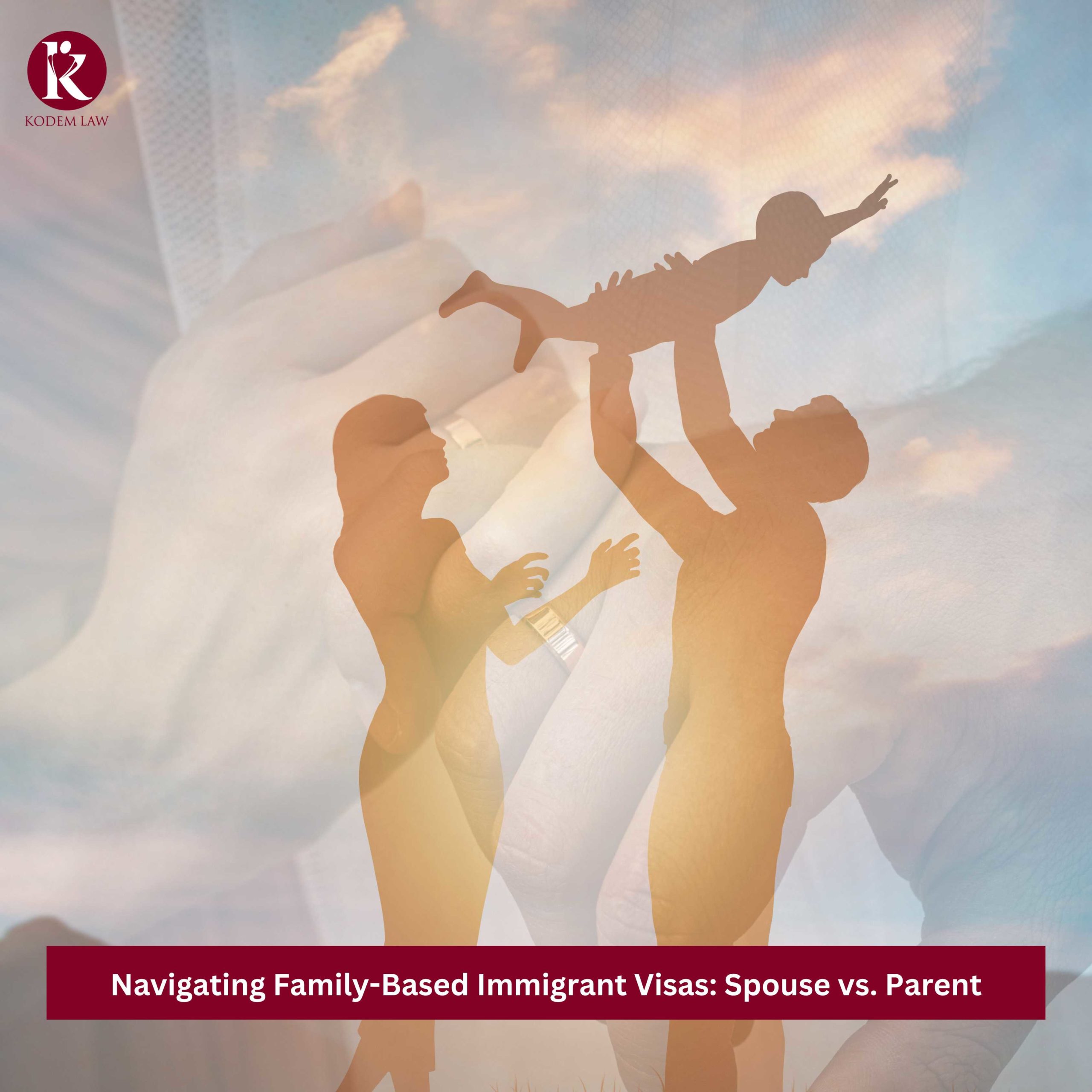
Family-based immigrant visas offer a path to reuniting with loved ones in the United States, but the process can vary significantly depending on whether you are filing for a spouse or a parent. Understanding these differences is crucial for ensuring a smooth application process. This article breaks down the key distinctions between filing for a spouse versus a parent, guiding you through eligibility requirements, application processes, and common pitfalls to avoid.
Overview of Family Based Immigrant Visas
Family based immigrant visas provide a pathway for close relatives of U.S. citizens and lawful permanent residents to immigrate to the United States. This process is crucial for family reunification, enabling loved ones to live together in the U.S. These visas are categorized into two primary types based on the relationship between the petitioner and the beneficiary:
Immediate Relative Visas
- Definition: These visas are for close family members of U.S. citizens. They are not subject to annual numerical limits, which can expedite the application process.
- Eligibility: Includes spouses, unmarried children under 21 years old, and parents of U.S. citizens who are at least 21 years old.
- Process: Typically involves submitting Form I-130 (Petition for Alien Relative), followed by either consular processing or adjustment of status, depending on the beneficiary’s location.
- Advantages: Faster processing times due to the absence of annual caps and priority processing.
Family Preference Visas
- Definition: These visas are for more distant relatives of U.S. citizens and for relatives of lawful permanent residents. They are subject to annual caps, which can lead to longer waiting periods.
- Categories:
1. First Preference (F1): Unmarried adult children (21 years or older) of U.S. citizens.
2. Second Preference (F2A): Spouses and minor children of lawful permanent residents.
3. Second Preference (F2B): Unmarried adult children of lawful permanent residents.
4. Third Preference (F3): Married children of U.S. citizens.
5. Fourth Preference (F4): Siblings of U.S. citizens, provided the citizen is at least 21 years old.
- Process: Similar to Immediate Relative Visas, but requires waiting for a visa number to become available, leading to potentially longer wait times due to annual caps.
- Challenges: Extended waiting periods due to visa quotas and more complex processing due to the high demand and annual limits.
Filing for a Spouse: Immediate Relative vs. Family Preference Visas
The family-based immigrant visa process for a spouse can be complex. Here’s a clear guide to help ensure a smooth and efficient application.
Eligibility Requirements
- Immediate Relative Visa: This visa is for the spouse of a U.S. citizen, offering the advantage of no annual limits, which accelerates both processing and entry. To apply, you need to submit Form I-130, which generally leads to faster approval and a quicker path to reunification.
- Family Preference Visa: This visa is available to the spouse of a lawful permanent resident (green card holder). Unlike Immediate Relative Visas, it is subject to annual quotas, which can result in extended wait times. Applicants must wait for a visa number to become available, potentially leading to delays in processing and entry.
Application Process
- Step 1- File Form I-130: Submit the Petition for Alien Relative to USCIS to start the process.
- Step 2- Visa Application: After approval, your spouse will either apply for an immigrant visa through consular processing if outside the U.S. or adjust status if already in the country.
Supporting Documents
- Marriage certificate.
- Proof of a bona fide relationship (photos, joint accounts).
- Evidence of U.S. citizenship or lawful permanent residency of the petitioner.
Timelines
- Immediate Relative Visa: Generally quicker due to no annual caps.
- Family Preference Visa: This may take longer due to annual caps and visa number availability.
Additional Considerations
- Ensure all documents are accurate to avoid delays.
- Consular processing involves an interview at the U.S. embassy or consulate.
Filing for a Parent: Immediate Relative vs. Family Preference Visas
Eligibility Requirements
- Immediate Relative Visa: Available for parents of U.S. citizens who are at least 21 years old. This visa is not subject to annual caps, enabling faster processing.
- Family Preference Visa: This visa category does not apply to lawful permanent residence. Parents of lawful permanent residences are not eligible under any family preference category.
Application Process
1. File Form I-130: Submit the Petition for Alien Relative to USCIS to start the process.
2. Visa Processing: After approval, your parent will need to apply for an immigrant visa through consular processing if outside the U.S., or adjust their status if already in the country.
- If Your Parent is Outside the U.S.: They will complete visa processing at the local U.S. consulate following approval.
- If Your Parent is in the U.S.: They may file Form I-485 to adjust their status to permanent residence without leaving the country.
Note: This approach provides a clear pathway based on whether your parent is inside or outside the U.S.
Supporting Documents
- Proof of U.S. citizenship (e.g., birth certificate or naturalization certificate).
- Evidence of the parent-child relationship (e.g., birth certificate showing parent’s name).
- Form I-130 and relevant fees.
Additional Considerations
- Ensure all documents are accurate and complete to avoid delays.
- Be prepared for an interview at the U.S. embassy or consulate if applying from abroad.

Key Differences Between Spouse and Parent Visa Applications
Aspect | Fiancé(e) Visa (K-1 Visa) | Spouse Visa (CR-1/IR-1 Visa) | Parent Visa (IR-5 Visa) |
Purpose | For a fiancé(e) of a U.S. citizen to enter the U.S. to marry. | For a foreign national spouse of a U.S. citizen or permanent resident to immigrate to the U.S. | For a foreign national parent of a U.S. citizen who is at least 21 years old to immigrate to the U.S. |
Eligibility | Must be engaged to a U.S. citizen and marry within 90 days of entering the U.S. | Must be legally married to a U.S. citizen or permanent resident. | Must be a parent of a U.S. citizen who is at least 21 years old. |
Application Form | Form I-129F (Petition for Alien Fiancé(e)) | Form I-130 (Petition for Alien Relative) | Form I-130 (Petition for Alien Relative) |
Processing Time | Typically faster for initial approval but requires marriage within 90 days of entry. | May take longer due to processing times and additional steps. | Generally faster due to Immediate Relative status and no annual caps. |
Visa Status | Non-immigrant visa converts to immigrant status upon marriage and adjustment of status. | An immigrant visa provides permanent resident status upon entry if the application is approved. | The parents of U.S. citizens who enter the U.S. with an IR-5 visa will become lawful permanent residents (green card holders) immediately upon entry. |
Adjustment of Status | Must apply for adjustment of status after marriage to become a permanent resident. | Automatically adjusts to permanent resident status upon entry to the U.S. if approved. | Automatically adjusts to permanent resident status upon entry to the U.S. if approved. |
Work Authorization | Can apply for a work permit after marriage and adjustment of status. | Can work upon entry to the U.S. as a permanent resident. | Can work upon entry to the U.S. as a permanent resident. |
Travel Restrictions | Must marry within 90 days of entering the U.S.; restricted travel until marriage. | Can travel freely as a permanent resident once in the U.S. | Can travel freely as a permanent resident once in the U.S. |
Supporting Documents | Proof of relationship, intent to marry within 90 days, evidence of meeting in person within 2 years (with exceptions). | Proof of marriage, evidence of a bona fide relationship, and documentation related to the petitioner’s status (U.S. citizen or permanent resident). | Proof of parent-child relationship, evidence of U.S. citizenship of the child, and supporting documentation. |
Fees | Generally, lower initial fees compared to a spouse visa. | Higher overall fees due to the immigrant visa process and adjustment of status. | Similar to spouse visa fees, with costs associated with the immigrant visa process. |
Common Pitfalls and How to Avoid Them
- Incomplete Documentation: Ensure all required documents are submitted and are accurate. Missing or incorrect documents can cause delays.
- Misunderstanding Eligibility Requirements: Verify the specific eligibility criteria for the visa category you are applying for to avoid complications.
- Ignoring Timelines: Be aware of processing times and plan accordingly to avoid unexpected delays.
- Inadequate Proof of Relationship: Provide thorough evidence to establish the validity of your relationship to avoid additional requests for information or interviews.
How Kodem Law Can Assist You
At Kodem Law, we specialize in guiding you through the complexities of family based immigrant visa applications. Our experienced team provides comprehensive support, from preparing and reviewing documentation to representing you in case of approvals or denials. We are committed to making the process as smooth and efficient as possible, ensuring you can focus on reuniting with your loved ones. Reach out to Kodem Law today for expert assistance and personalized support throughout your immigration journey.

